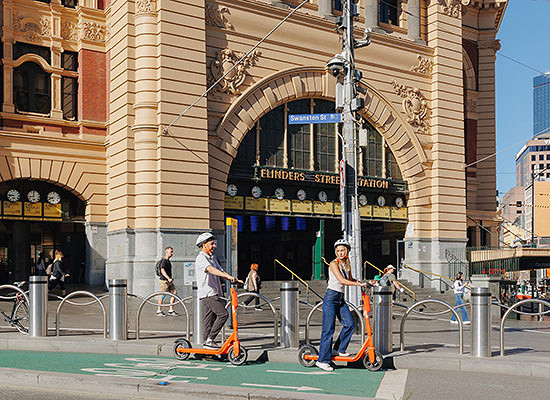E-scooter injuries on the rise, new Royal Melbourne Hospital data shows
The Royal Melbourne Hospital’s trauma program manager Kellie Gumm has expressed concern about the dangers of e-scooter use as patients suffering serious injuries continue to climb.
Ms Gumm said they were seeing many patients presenting with broken arms and fingers, as well as brain injuries, which she noted could have long-term consequences for people.
“Sometimes we see a combination of arm fractures with both arm fractures or one arm fracture and some broken ribs if the upright part of the scooter goes into their chest or they land hard on the ground,” she said.
According to new data from the Royal Melbourne Hospital, 247 riders and nine pedestrians who presented at the hospital because of e-scooter falls or collisions in 2022, 21 per cent of which were identified as major trauma.
Most patients were male (69 per cent) with an average age of 29, the study found, with alcohol (34 per cent) and not wearing a helmet (33 per cent) being among the main factors contributing to injuries.
Half the patients suffered head, neck, or face injuries, with the cost of medical procedures and operations estimated to be at $1.9 million.
The report, published in December 2023, found the findings “underscore the urgent need for improved safety measures to minimize electric scooter-related injuries and their clinical and economic repercussions”.
“Despite the potential environmental benefits, e-scooter usage presents a growing public health concern with an increasing financial burden to local healthcare systems,” the report said.
However, the data does not distinguish between private and rental e-scooter injuries.
Private e-scooters, which were legalised in October 2023 after the state government extended the e-scooter shared hire scheme operated by Neuron and Lime, lack the safety features of the rental e-scooters, and can reach up to speeds of 100km/h.
Ms Gumm, who was one of eight authors behind the report, said it was hoped the data may inform policy makers “to try and help make the right rules” if e-scooters were to be made a long-term part of the urban transportation landscape.
“We need to improve safety, particularly if it’s going to be a permanent fixture,” she said.
“We saw a significant increase in 2022, prior to that we may have seen maybe one or two electric scooter related injuries a year.”
Speaking of drink-riding, Ms Gum said she believed this was related to people jumping on an e-scooter after a night out and “maybe not making the best choices when you’ve had a few drinks” including opting not to pay a higher fare for a taxi or Uber.
She said the hospital had also seen drug use, with most accidents, overall, occurring between 8pm and 1am.
Ms Gumm added there were responsible rides who followed all the rules but may have an unforeseen fall.
“We might see someone using an e-scooter for commuting to and from work, aged in their mid-40s, and if it’s dark without good lighting, they may hit a pothole,” in which case “generally you go straight over the top of the e-scooter”.
Neuron and Lime said safety was their top priority with 99.99 per cent of the 2.7 million total trips undertaken in 2022 ending safely and without incident.
“Neuron’s e-scooters are purpose-built for safety and renting and are packed with the latest safety technology, much of it not seen on private e-scooters, including geofencing technology that controls where e-scooters are ridden and parked, and how fast they can travel,” a Neuron spokesperson said.
“Other features include an app-controlled helmet lock which integrates a helmet to every e-scooter, Follow My Ride, triple-0 emergency button, and a topple detection feature.”
A Lime spokesperson said the report highlighted a need for education, noting as a shared operator, it had no tolerance for illegal behaviour and used technology such as a cognitive test to mitigate the risk of impaired riding.
“In 2023 we were able to reduce our injuries per million trips by 22 per cent. Top locations where incidents occurred are all designated cycling facilities and identified for upgrades as part of the strategic cycling corridors network,” the spokesperson said.
“It is worth noting this study mentions that there is no insurance for riders. Lime has full comprehensive insurance in place, to cover both riders and the general community.”
Under the trial, riders must be aged 16 or over and must wear a helmet, as well as adhere to the same blood alcohol content and drug use restrictions as motorists. They also cannot travel above 20km/h, which the rental e-scooters are capped at.
The government said the trail’s extension to April would ensure its datasets were comprehensive.

Council endorses office tower at Flinders Lane despite querying car park demolition






 Download the Latest Edition
Download the Latest Edition